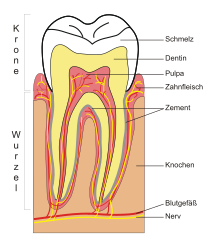Enamel
The enamel , even adamantine ( n. Mentioned), ( neulateinisch filmstrip final and substantia adamantinea ) is the outer layer of the teeth of the terrestrial vertebrates (Tetrapoda) and is located in the area of the tooth crown to the dentin (dentin) on.
construction
Tooth enamel is the hardest tissue in the human body with a Mohs hardness of 5. It contains compounds of calcium , phosphorus , magnesium and sodium , and proteins and fats are also involved in its structure. Enamel is 95% inorganic and consists largely of the phosphate [Ca 5 (PO 4 ) 3 OH] x2 ( hydroxyapatite ). However, this substance is acid soluble. When viewed with an electron microscope, tooth enamel consists of ribbon-shaped crystallites grouped in bundles . These are known as prisms and are usually perpendicular (at a 90 ° angle ) to the enamel surface. However, enamel prisms are limited to the teeth of mammals . In accordance with its structure, Schmelz shows a color spectrum that ranges from reddish to blue-gray. Due to the diffraction of light on the smallest components, there is an iridescence. It also shows opalescence .
Tooth enamel is ontogenetically formed in the ectoderm in a special enamel organ of adamantoblasts through biomineralization , cells of epithelial origin that come from Hertwig's epithelial sheath.
The melting point of tooth enamel is 1620 ° C.
Dentistry
Tooth enamel is not permeated by nerves and cannot be reproduced . Therefore, dental caries does not cause pain as long as it has not penetrated through the dentin to the pulp. However, the degraded material must be removed and the tooth "repaired" with other materials. Enamel caries can be remineralized again by dietary guidance and frequent administration of low-dose fluoride (so-called fluoridation ), whereby the hydroxide ions in the apatite are replaced by the fluoride to form fluorapatite . Only when the caries has broken through the enamel layer and is spreading in the underlying dentine is a filling therapy indicated in terms of minimally invasive dentistry .
The enamel can be reduced mechanically, usually by abrasion with too frequent and too vigorous brushing as part of dental care . The chemical process caused by acidic foods causes tooth enamel to erode .
history
In the pre-microscopic era of the 16th and 17th centuries, Bartholomäus Eustachius (1500 / 1513–1574), Marcello Malpighi (1628–1694) and Johann Jakob Rau (1668–1719) researched the structures of hard tooth tissue and their origins. With the development of optical magnification aids, especially by Antoni van Leeuwenhoek (1632–1723), more precise histological examinations of the tooth structure and discoveries in the area of the histological processes during the embryonic phase of the teeth are possible. Malpighi postulates the secretion theory of melt formation by means of an ossifying juice; Eustachius mentions the conversion theory for the first time. Alexander Nasmyth (1789–1848), Richard Owen (1804–1892), Anders Adolf Retzius (1796–1860), Jan Evangelista Purkyně (1787–1869), Albert von Kölliker (1816–1905), Wilhelm von Waldeyer (1836–1921 ), Viktor von Ebner-Rofenstein (1842–1925), Gustav Preiswerk (1866–1908), John Tomes (1815–1895) as well as his son Charles (1846–1928) and many other researchers gave dental histology a thorough study of the a broad scientific basis throughout the area. To date, however, there is still no generally recognized uniform picture of the histological structure of a tooth and its development. Questions to be answered include the organic substance of the enamel, the prismatic sheaths, the interprismatic substance or cement substance and the enamel development.
See also
- Dental cement
- Tooth pulp
- Amelogenesis imperfecta , disruption of tooth enamel formation
Web links
- Hard biters. A complex layer system gives the tooth enamel its enormous resilience. On: Wissenschaft.de from August 21, 2010.
Individual evidence
- ↑ a b c d Ulrich Lehmann: Paleontological dictionary . 4th edition, Enke Verlag , Stuttgart 1996, page 213.
- ↑ Temperature rise caused by laser (CO2, Nd: YAG, Er: YAG) irradiation of teeth Fumio Hirota, Keiichi Furumoto, Department of X-ray Analysis, Dental Research Institute, Nippon Dental University, 1-9-20 Fujimi, Chiyoda, Tokyo, Japan.
- ↑ Nina Eckardt, The History of Histogenesis and Histology of Tooth Enamel between 1770 and 1890 , Dissertation 2001. Retrieved on October 4, 2016.


